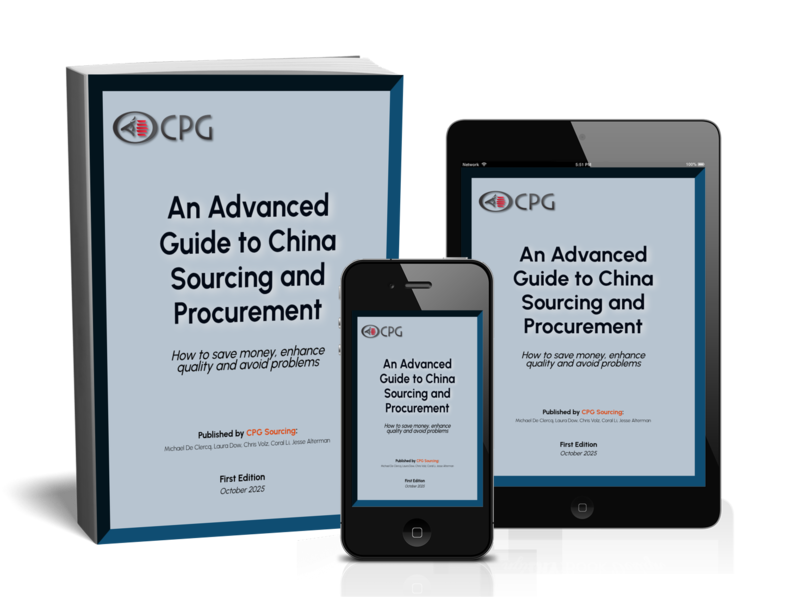Inside the First Two Chapters of An Advanced Guide to China Sourcing and Procurement
November 18, 2025

We’re proud to share a closer look at the first two chapters of our upcoming e-book, “An Advanced Guide to China Sourcing and Procurement.” Written by the CPG Sourcing team, this guide distills decades of hands-on experience into practical strategies for companies sourcing directly from Chinese manufacturers.
Our goal in writing this book was simple: to create the kind of resource we wish had existed when many of us first started in sourcing and supply chain management. Over the years, we’ve helped companies importing millions of dollars in goods from China improve margins, strengthen compliance, and avoid costly mistakes. Again and again, we saw the same issues surface: poor communication, weak supplier oversight, and a lack of clear processes. This book is our way of addressing those gaps head-on.
CPG CEO, Michael De Clercq, and Business Director, Laura Dow, walked through the first two chapters of the book in Episode 5 of CPG’s podcast, The Supply Chain of Thought.
Chapter 1: Managing On-Site Sourcing Operations
Our first chapter focuses on one of the biggest strategic decisions a company can make…whether to manage its sourcing program through an in-country team or from abroad.
For many importers, especially those buying between $1 million and $10 million annually, this is a critical consideration. Having a local presence in China can dramatically improve oversight, communication, and quality control, but it also introduces a new layer of complexity.
We’ve seen both sides of this equation. Some clients have opened China offices to gain tighter control over their operations, only to face new challenges such as staff management, legal obligations, and even trust and compliance issues. Others have tried to manage remotely, only to lose visibility into what’s actually happening on the ground.
In this chapter, we break down what to evaluate before opening a sourcing office, including scale, cost, and structure, and what systems to put in place to keep it efficient and transparent. There are often-overlooked realities of managing teams in China, from cultural expectations and communication styles to regulatory requirements like social insurance contributions and severance.
The takeaway from this chapter is that having people on the ground is crucial, but managing them effectively is what determines success. Whether a business maintains its own office or partners with a trusted sourcing firm, the key is transparency, clear systems, and accountability.
Chapter 2: Navigating Verified Sustainability in China’s Supply Chains
The second chapter, written by Laura Dow, focuses on sustainability, an area that has rapidly evolved from a branding concept to a compliance requirement.
Starting in 2026, large companies in the EU will be required to report Scope 3 emissions under the Corporate Sustainability Reporting Directive (CSRD). That means every component of the supply chain (from raw material extraction to product disposal) must be tracked, audited, and verified by a third party.
This shift has major implications for companies sourcing from China. Many of our clients now need to collect detailed data from factories, logistics providers, and packaging suppliers to remain compliant. The challenge is that much of this data isn’t easily accessible, and verifying it at the source can be difficult.
In this chapter, we explore how to build sustainability verification into the sourcing process rather than treat it as a separate initiative. That includes mapping the supply chain, developing ESG audit checklists, and aligning incentives with suppliers who meet or exceed sustainability standards.
We also discuss a crucial mindset shift: sustainability doesn’t have to mean higher costs. When managed well, it can lead to process efficiencies, reduced waste, and stronger supplier relationships. Factories that embrace responsible production tend to be better organized, more consistent, and easier to work with long-term.
The larger message is that verified sustainability isn’t optional. It’s becoming a global expectation. Companies that take it seriously now will have a competitive advantage as regulations continue to tighten and customers demand more transparency.
Why We Wrote This Book
The sourcing landscape has changed dramatically in recent years. It’s no longer just about getting the lowest price. Buyers now need to balance cost, compliance, risk, and responsibility.
Our team wrote An Advanced Guide to China Sourcing and Procurement to help companies navigate that complexity. The chapters that follow dive deeper into quality assurance, negotiation, and communication. If these topics resonate with you, we invite you to listen to our podcast episode below, where we discuss the book in more detail and share additional real-world insights from our team.
And if you’d rather read than listen, you can find the full transcript here.
